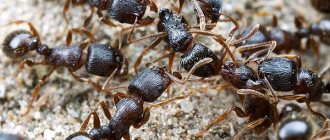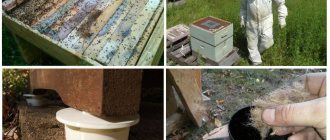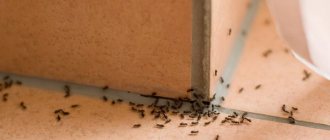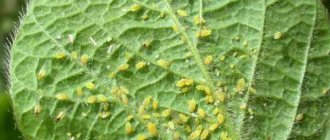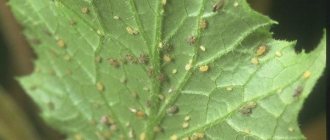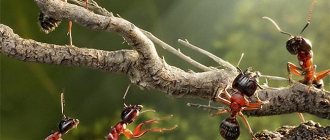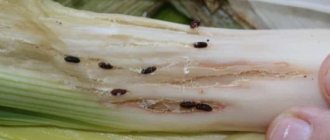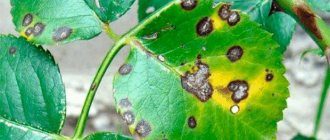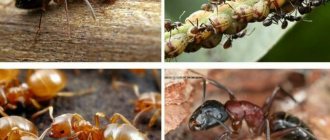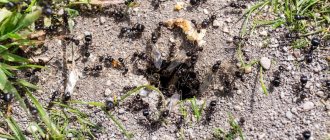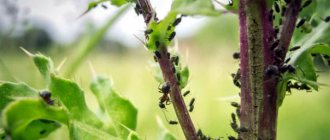Folk remedies for household pests
The modern market is oversaturated with various insect control products. All of them contain aggressive substances. For this reason, people prefer folk remedies that cause minimal harm and give positive results when used systematically.
Their essence lies in 3 areas:
- repelling ants using plants, products, etc.;
- luring insects for further destruction/removal outside the home;
- poisoning.
The effectiveness of such remedies has been proven over decades and the experience of millions of people, which is why folk recipes are popular.
Prevention of ants
To prevent the appearance and reproduction of insects in your summer cottage, follow the following preventive measures:
- plant aromatic plants - mint, garlic, wormwood, etc.;
- destroy insects in a timely manner as soon as you find them on the site, preventing active reproduction and rapid population growth.
When choosing means of control and prevention, consider not only their effectiveness, but also their safety for humans, animals and cultivated plants.
Lures
The purpose of baits is to lure all insects at the same time to one place, where a trap or poisonous substances awaits them. For this purpose, products are used that have a pleasant aroma for ants (to attract them).
With boric acid
This is a recognized substance among gardeners. To prepare the product, a powder mixture is used, which can be purchased at a pharmacy.
Peculiarities:
- a weak concentration of the substance does not destroy immediately, it acts gradually (the ant, returning to its home, regurgitates the remains of food with acid, as a result of which it poisons all other family members);
- strong concentration kills instantly;
- boric acid helps to sterilize females and males, so the reproduction process stops.
Best recipes:
- Add 20 g of boric acid to 400 ml of water. Add a little jam, honey or sugar to attract. Use the liquid to trap (pour into open bottles) or spray the paths of insects.
- Take mashed potatoes or minced meat, mix in a 2:1 ratio with acid. Form into balls and place in a place accessible to insects.
- In 1 tsp. (5 g) boric acid, add boiled or raw egg yolks (4 pcs.). Pour in a little fragrant vegetable oil and stir in enough flour to form flour crumbs. Scatter it in the favorite areas of insects.
- Combine 1 tsp. acids with 4 tsp. glycerin, 1 tbsp. l. water and sugar (the amount is arbitrary). Make balls. Place them in areas where ants often appear.
It is recommended to leave the bait for a month. Additionally, the poison will destroy cockroaches.
With borax
Borax is considered as effective as boric acid. Compositions are made from it:
- 1 part granulated sugar, 0.5 parts substance. Place in lids from jars and plastic bottles. Place containers near potential anthills.
- To the same mixture, add water mixed with honey to form a paste. Used against house ants. Apply the mixture onto pieces of cardboard and place it on the floor.
With baking soda and cereals
The alkaline substance destroys ants. It is enough to sprinkle soda on the path along which insects move or fill up the entrance through which they enter the house.
The second option is to mix soda with water until a paste forms, adding a little honey. Pour into caps. Place the containers at a short distance from the ants’ homes.
The safest method is to scatter millet grains on the floor or pour them into an anthill. The principle of action is that millet, when mixed with gastric juice, swells greatly and clogs the stomach. The process leads to the death of the pest.
With starch and yeast
The yeast, after being eaten, swells in the ant's stomach. Starchy substances affect the gastrointestinal tract. This is fatal to the insect. The products are used individually or together:
- Dissolve the yeast in warm water, adding a little honey. Pour into the caps. Place it around the apartment.
- Sprinkle the anthill with a dry mixture of starch, ground black pepper and salt.
Additionally, you can add a little boric acid to the composition.
Sweet baits
Ants have a big sweet tooth. This is especially true for domestic pests. They can often be seen near sugar bowls and saucers with jam. Sweet baits are designed for this weakness.
First way:
- Pour 2 tbsp into 200 ml of water. l. sugar or 1 tbsp. l. honey/jam.
- Pour the solution into a shallow container. Place it on the floor. Ants, hoping for a “sweet treat,” will drown in the liquid.
Second method:
- Spread 2–3 mm thick stationery glue over a piece of cardboard.
- Place a treat (sugar, honey, jam, candy, etc.) in the center.
- Place the trap in the area with the greatest concentration of insects.
Most often, ants crawl towards such a trap at night. The downside is that the glue dries quickly, so you have to make a new trap every evening.
Repellers
This method involves the use of products that have an odor that ants cannot tolerate. As a result, insects will begin to leave the house.
Plants
The gentle method involves the use of fresh and dried plants. These include spices and seasonings.
Ants cannot tolerate:
- mint, lavender, parsley, chamomile - herbs are hung in the kitchen or laid out in places where insects often appear;
- anise, cloves, bay leaf, hot peppers - pour seasonings into fabric bags and hang them at the bottom of the wall closer to the floor;
- garlic - cut the cloves in half, spread around the room or lubricate the ant paths with juice;
- lemon - application is identical to the previous one;
- geranium - growing indoor plants on windowsills.
Essential oils
There are benefits to using essential oils. The smell does not disappear for a long time, the aroma spreads over a large area. Contraindication: allergic reaction. Cannot be used if infants and children 2–3 years old live in the home.
Effective oils:
- orange;
- eucalyptus;
- mint;
- juniper;
- fir;
- needles.
Application options:
- mix with water, spray or wash the floor;
- put a jar of oil in an open position;
- light incense sticks.
Vinegar, ammonia and other means
Pharmaceutical preparations are also widely used to control pests. One of them is ammonia. Ants cannot tolerate the ammonia smell.
How to prepare and use the product:
- Pour one bottle of ammonia (100 ml) into 1 liter of water.
- Treat all surfaces on which insects move.
- Wash the floor.
Ammonia has a pungent odor. Children, allergy sufferers and pets should not be present in the room being treated. The use of a respirator is mandatory. The “aroma” disappears after 25–35 minutes.
Other means:
- Take vinegar, soak a piece of cloth in it, wipe the baseboards, floor, table and chair legs, trash can, walls.
- Apply Vaseline to the entrances through which ants enter the apartment.
- Place tobacco from 1 cigarette in 200 ml of water, let it brew for 24 hours, add 2-4 drops of iodine, spray around the room.
- Draw chalk “barriers” through which insects will not crawl.
Food products
There are a number of food products with odors that are unacceptable to pests. Most of all, ants don't like coffee. To repel, burnt natural grains (insoluble analogue) are used. Place the grains around the room in random order or leave an open jar on the table.
Other repellent products:
- Peel the orange/grapefruit and place the peel around the house;
- leave smoked sausage, lard, etc. in the kitchen;
- buy smoking liquid, soak the sawdust in it, put it in open containers, and place it in the room.
Rules for getting ants out of your home
The main reason for entering a house is the search for food, drink and warmth. Ants are most often localized in the kitchen. After entering the house, insects form nests that are inaccessible to humans (behind baseboards, etc.).
In the fight, the first thing to do is to discover the anthill. To do this, you should study the vital activity of insects.
Organization of ant life
House ants are organized individuals with excellent memory. If they find food once, they return to this place again, bringing relatives with them.
Before entering the house, ants can settle in garbage chutes, garbage cans and other places where rot accumulates. They are carriers of infection.
Ant colonies are used to migrating. They can travel long distances to find food. There is a scout in their family who is the first to set off. After finding a favorable place, he leads the others.
Other features:
- these insects are not picky eaters, but prefer meat products and sweets;
- It is important for them that the room be warm;
- the queen ant is always hiding, laying eggs;
- Foragers (working individuals) always move along a certain path when they return to the anthill (they leave behind a trail of pheromones, along which they again go to the food source).
You can't kill insects that get food. They feed the queen and other workers who are designed to care for the offspring. It is important that the brothers bring poisoned food to the “house” to feed the queen. This is why boric acid cannot be diluted in strong concentrations.
How do ants get into the house?
Small insects use various options for entering a person’s home.
Methods:
- through cracks and openings (in doors, windows, walls);
- through the ventilation and piping system;
- from the basement;
- brought into the house with fruits and vegetables, food, and any items from the street;
- carried on shoes.
Maintaining a cleaning routine
Keeping your home clean is an important factor in pest control.
Simple rules of sanitation:
- do not leave food on the table, floor or other surfaces, wipe away crumbs, etc.;
- close the trash can with a tight lid, regularly remove garbage from the apartment;
- wipe the sink dry, do not leave water open (ants are attracted to moisture);
- wash and dry cat/dog dishes;
- Wash the floor more often with special cleaning products or vinegar.
Why ants settle in houses, why they are dangerous and how to deal with them - watch the video.
Ants on the site: benefit or harm?
First, it's important to understand one thing: ants are almost inevitable. They come thoroughly and for a long time, build their shelters and create entire colonies. Most often they appear in the most inappropriate places - in the middle of a plantation or between berry bushes.
There are no truly effective measures that would help prevent the attack. Ants prefer to settle in good fertile soil, in warm areas with healthy humidity. But let's first figure out what the real harm is from uninvited guests and is there any benefit from them?
Photo: vpr.org
We know from school that ants are forest orderlies, because they destroy small pests on an astonishing scale. There are literally thousands and kilograms of larvae, beetles, caterpillars and ovipositors. But at the same time, they “breed” aphids, which then consume all fruit and berry plantings.
Soil with ants is 2 times richer in potassium and as much as 10 times richer in phosphorus, and in the form in which they are best absorbed by plants. But ant colonies irreversibly damage everything in their path. They readily feed on roots, berries and leaves themselves. They like sweet flowers or buds, and over time they can even move into the house.
Photo: factroom.ru
Folk remedies for fighting ants in the garden
The use of folk remedies to get rid of ants in the garden is justified by the fact that chemical poisons will not penetrate into the soil, which happens when using store-bought products. Some substances require careful handling.
Boiling water and kerosene
A simple method is to fill the anthill with boiling water.
How to do it:
- Find an anthill and stir it with a shovel, which will allow the boiling water to penetrate deeper.
- Pour in 4-6 liters of hot water.
- Repeat the procedure 3-4 times.
To enhance the effect, add vinegar, essential oil, etc. to the water. The disadvantage of this method is that the pests will most likely move the anthill to another place in the same area.
A more effective way is to use kerosene. There are 2 options:
- Dilute 5 tbsp in 5 liters of water. l. kerosene. Pour into the anthill.
- Soak rags in clean kerosene and place them around the anthill. Avoid contact with plants.
Ash, pepper, mustard powder
A useful method is to use ash, which is a natural fertilizer. The ash solution destroys ants and aphids. For prevention, ash is scattered around the garden or placed in holes with seedlings.
To fight, you will have to prepare an infusion. There are 2 recipes:
- Add 3 kg of wood ash to 10 liters of water, leave for 48 hours, strain, add 100 g of crushed laundry soap. Pour into the anthill.
- Add 150 g of ash to boiling water (500 ml), simmer over low heat for 30–40 minutes. Dilute with water to a volume of 5 liters, add 50 g of laundry soap. Fill the anthill.
Ants are afraid of hot peppers. You can use ground black and red product. To process it, just sprinkle the spice on the anthill and the paths along which the insects move.
Another option:
- Buy an alcohol-based tincture of capsicum at the pharmacy.
- Dilute with water in a ratio of 1:7.
- Pour into the nest.
Ants will not come running to your garden plot if you sprinkle it with mustard powder around the entire perimeter. It will not be possible to get rid of a large number of insects using mustard. If there are still few pests, the following action will help:
- Prepare a solution of 10 liters of warm water and 100 g of mustard powder.
- Pour into the anthill. Additionally, spray nearby growing plants.
Recipes with soda
There are 3 ways to treat your garden with baking soda when fighting ants.
Application:
- Mix baking soda (kills) with powdered sugar (attracts with smell) in equal proportions. Sprinkle the anthill generously.
- Add 5-6 tbsp to 2 liters of boiling water. soda Fill the nest and cover with plastic wrap.
- Fill the anthill with baking soda and pour vinegar on top.
The last method is considered the most effective of all baking soda recipes.
Treatment with tar and lime
Lime is often used by gardeners to normalize soil acidity (lower pH). At the same time, the substance destroys pests. Pour dry lime into the anthill or make a lime mortar (as for whitewashing trees) and pour it into the nest.
For ants, mole crickets and aphids, birch tar and ordinary tar soap are used.
Methods:
- For 10 liters of warm water you need 100 g of soap, 5 tbsp. l. tar.
- Mix tar and sawdust in equal proportions, pour boiling water over it so that you get a steamed mass (not liquid).
Pour the mixture and place it on the ant hills. Repeat the procedure 3-4 times.
Ammonia and urine
Ammonia is rich in nitrogen, so the gardener does not risk anything when using it in the garden.
Recipes:
- Stir 100 ml of ammonia in 1 liter of water, pour the solution into the anthill.
- Periodically water the beds with ammonia solution - 5 ml of alcohol per 5 liters of water.
If you need to destroy aphids, spray the affected plants with a solution of 8 liters of water and 1 tbsp. l. ammonia.
A slightly strange but effective way is to use urine. To do this, the anthill needs to be filled with urine, since uric and hippuric acid kill pests.
How to get rid of goosebumps in the apiary and in the hives?
Experienced beekeepers know first-hand what an ant invasion is. This test may drag on for a long time. Because dealing with them quickly is impossible. The main thing is that you need to take into account the specific case, and only then select a specific method.
1. Strong odors
We chop the onions and spread them throughout the apiary. The vegetable has a pungent odor and will quickly repel insects.
You can also use: garlic cut into slices, smoked herring, parsley or tomato sprigs, cinnamon.
Also, I read on the forum that they are afraid of the smell of rotten fish, supposedly they run away from this unbearable stench with the whole family. No wonder I would have run away too...
2. Salt
It can be done in two ways:
- Spray the areas around the hives with saline solution.
- Sprinkle salt along the paths of ants and places where they accumulate. You can use ash, dry mustard or soda in the same way.
3. Processing the hive legs
To prevent ants from getting into the houses of striped workers, it is necessary to carry out preventive actions even before the pests appear:
- wrapping with double-sided tape;
- grease treatment;
- attaching medical cotton wool;
- wrapping with animal fur, except sheep.
When removing ants from hives, don't forget about the bees. Otherwise, if you overdo it, you will also breed bees. Approach this matter with caution.
How to protect fruit trees?
Ants are excellent at loosening the soil, but they damage the bark of trees. They need to be protected. Special methods are used for this.
Adhesive and repellent belts
To prevent insects from climbing up the trunk, make a repellent belt. There are many options:
- whiten with lime;
- wrap the barrel from below with tape;
- lubricate clotheslines with Vaseline and wrap the tree;
- Apply grease to the barrel.
Tie with foil (slippery side out and sharp edges). Make a design like a skirt.
Wrap polyethylene and coat with tar. Make the belt closer to the ground.
Water ditch and tires
To limit access to the trunk, dig ditches around the perimeter and fill them with cement mixture. When the concrete has hardened, pour in water.
For the same purpose, use tires from car wheels. To do this, cut in the center so that you get 2 rings. Insert through the crown onto the circum-trunk circle upside down. Pour water.
The second option is convenient when the tree is massive and it is impossible to thread a rubber ring through the crown. In this case, the tire is cut and inserted under the tree, and the cut edges are fastened with staples, etc.
To prevent insects from moving to the trunk, the rubber is lubricated with turpentine, oil and other oil-based substances.
What to do if folk remedies didn’t help?
If folk remedies do not bring positive results (this happens when there is an excessively abundant invasion of ants), you will have to use store-bought insecticides. They are available in different types:
- aerosol - quickly and conveniently used in an apartment (only working individuals die);
- solution - used in gardens, no need to dilute;
- the powder is universal, can be scattered and diluted in water;
- granular form - used for home and garden (a huge plus - harmful substances do not penetrate the respiratory tract);
- gel - convenient and effective for placement (ants carry the drug to the uterus);
- pencil - acts like a powder and is convenient to apply to walls;
- repeller - an ultrasonic device powered by mains or batteries (harmless to humans);
- trap - a device with gel that is glued to the wall.
When using folk remedies for domestic ants, try to choose those that do not kill insects instantly. Give them the opportunity to carry the poisoned food into the anthill. When fighting garden pests, take into account the percentage of harm to plants and soil. Save chemicals as a last resort.
Types of ants
Different types of ants are found everywhere in our country. They differ from each other not only in external signs, but also in the degree of harm caused.
Most often, the following varieties settle in the garden and vegetable garden :
- red domesticated (pharaonic, myrmica) - insects have a dark brown color and a body length of up to 6 mm;
- red wood borers - reach sizes up to 2 cm. They live in tree trunks, old stumps, and wooden houses. By building their moves, they can turn even a strong log into dust;
- black garden ants are working individuals 3-5 mm long, they settle in the root system of plants, which leads to their rapid death. They also contribute to the breeding of aphids, which adversely affects the harvest;
- red forest ants are working individuals 4-9 mm in length, and winged males are about 1 cm.
Ants feed on the sweet secretions of aphids, so in those places where there is an anthill, there will definitely be plants affected by this pest
For an ordinary summer resident (not an entomologist), it does not matter at all what kind of insects have settled on his plot, since ants of all Russian varieties bring the same harm and benefit to the plot.
